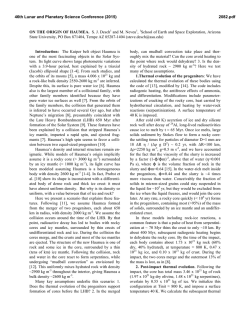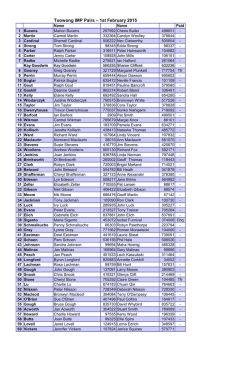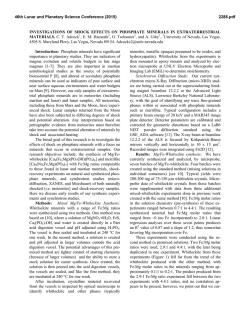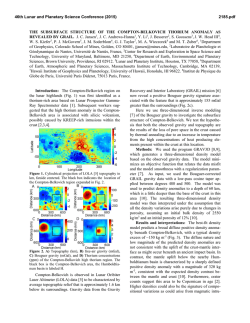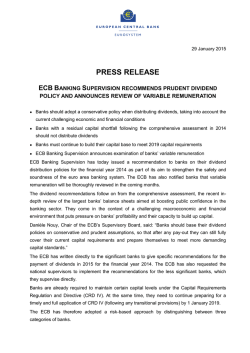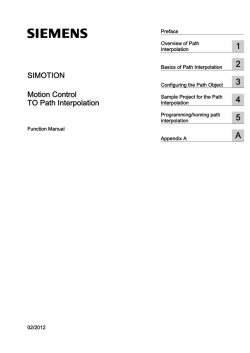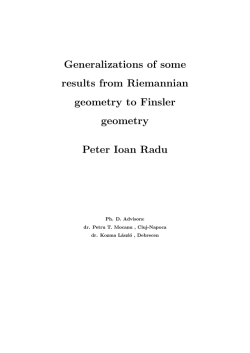
THE INTERNAL STRUCTURE OF HAUMEA. L. W. Probst1, S. J.
46th Lunar and Planetary Science Conference (2015) 2183.pdf THE INTERNAL STRUCTURE OF HAUMEA. L. W. Probst1, S. J. Desch1, and A. Thirumalai1. 1 School of Earth and Space Exploration, Arizona State University, PO Box 871404, Tempe, AZ 85287. ([email protected], [email protected]). Introduction: The Kuiper belt object Haumea is one of the most fascinating objects in the solar system. Its mass, measured from the orbits of its moons, is 4.006 x 1021 kg [1]. Its surface is pure water ice [2], but its inferred mean radius is about 718 km [3], implying a mean density 2580 kg m-3. The surface ice is a veneer over a rocky core. This model is supported by observations of Haumea’s light curve. Haumea shows large (Δm ≈ 0.3) photometric variations over a 3.9154 hour period [3]. Given the uniformity of its surface, the light curve cannot arise from albedo variations, but rather from varying area presented to the observer. Haumea’s optical light curve and thermal emission have been modeled successfully assuming Haumea is a triaxial Jacobi ellipsoid of uniform density ~ 2600 kg m-3 [3-6]. These studies are in agreement that if Haumea’s rotation axis is normal to the line of sight, and Haumea reflects with a lunar-like scattering function, then its mean radius is 715.2 km, its axis ratios are p=b/a=0.80, q=c/a=0.517, and its mean density 2600 kg m-3 [6]. These two results are in apparent conflict: Haumea cannot be uniform in density and also have a rocky core with an ice mantle. Assuming a mean density 2600 kg m-3, a rock density 3300 kg m-3 and an ice density 935 kg m-3, the ice mantle would comprise 30% of the volume of Haumea. This potentially could invalidate the common use of a Jacobi ellipsoid solution. Here we examine whether Haumea can have a rocky core and ice crust and remain in hydrostatic equilibrium. Based on the fit to the light curve, we assume the surface is a triaxial ellipsoid with fixed axis ratios p=b/a and q=c/a. We then model the core assuming it has given density ρc and is also a triaxial ellipsoid with axis ratios pc=bc/ac and qc=cc/ac that are free to vary. We then calculate the angle between the gravity vector and the normal to the surface, along both the coremantle boundary (CMB) and the imposed outer surface. If either surface deviates enough from an equipotential, a tangential gravitational acceleration would move material along that surface. Methods: We calculate the gravitational potential within Haumea by using finite element analysis to model its mass distribution on a Cartesian grid with 603 zones in each octant. We use Monte Carlo methods to calculate the mass in zones that overlap the rocky core and ice mantle, or overlap the ice mantle and space. We then generate ~103 points along the CMB or along the outer surface. We calculate the effective gravita- tional acceleration by summing the contributions to the gravitational acceleration at each point from all zones, and adding the centrifugal force away from the rotation axis (coincident with the shortest axis). This vector is then compared to the (analytically derived) vector normal to the surface. Defining the angle between these two vectors as θ, we average the value of cos θ over each surface. We define the “fit angle” as the inverse cosine of this average of cos θ. For surfaces that are equipotentials, the fit angle is zero. Because of the coarseness of the grid, we find small deviations of the fit angle from zero, ~10-2 radians, or about 0.5°. This is smaller than the deviations we find. We have calculated the fit angle on both the CMB and the outer surface, as a function of the free parameters pc and qc, for three different values of the core density: 2700 kg m-3, 3000 kg m-3, and 3300 kg m-3. The surface axis ratios are fixed on a set of particular dimensions, the mass of Haumea was fixed at 4.006 x 1021 kg, and its mean density at 2600 kg m-3. The core axis ratios were allowed to vary over the range allowed for Jacobi ellipsoids with this density and rotation rate: 0.43 < qc < pc < 1 [7]. These are presented as contour plots as in Figures 1-4. Results: A variety of shapes for Haumea’s outer surface were tested, including ellipsoids with the following outer dimensions (p,q): Jacobi ellipsoids with (p,q)=(0.88, 0.55) [3], (0.43, 0.34) [3], and (0.80, 0.52) [6]; and oblate Maclaurin spheroids with (p,q)=(1,0.58) [3], and (1, 0.70) [3]. We present the two cases for which reasonable fits to equipotentials on both the CMB and outer surface are possible with the same (pc,qc): the Maclaurin spheroid with (p,q)=(1,0.70), and the Jacobi ellipsoid with (p,q)=(0.80,0.52). For the Maclaurin spheroid the fit improved at higher density, and the ρc=3300 kg m-3 case is shown in Figs. 1 and 2. If (pc,qc)=(1,0.7), both the CMB and outer surfaces are nearly equipotential surfaces. But this case is unlikely because ad hoc albedo variations (inconsistent with Haumea’s uniform ice surface) would be required to explain its light curve [3,6]. For almost all cases, the fit improved as the core density decreased. In the limit that ρc=2580 kg m-3 the fits must become exact. One provided a reasonable fit at ρc=2700 kg m-3, the case of [6] with (p,q)=(0.80,0.52) [a=960 km, b=770 km, c=495 km], shown in Figs. 3 and 4. Conclusions: With the one exception of the unlikely Maclaurin spheroid, the CMB and outer surfaces conform to equipotential surfaces only for nearly ho- 46th Lunar and Planetary Science Conference (2015) 2183.pdf mogeneous bodies. We strongly favor Haumea not being differentiated into rocky core (ρc > 3000 kg m-3) and ice mantle, instead being nearly uniform in density with a thin (< 30 km) icy crust. The low density of Haumea suggests it is made of hydrated silicate [8]. Figure 3. Same as Figure 1 but for the Jacobi ellipsoid with (p=0.80, q=0.52, core density ρc=2700 kg m-3). Figure 1. Average fit angle (°) on the outer surface for the Maclaurin spheroid (p=1,q=0.7,core density ρc=3300 kg m3 ), as a function of core axis ratios pc and qc. The core axes that allow the outer surface to be an equipotential are (pc,qc) ≈ (1,0.7) (similar to the outer surface axis ratios). Figure 4. Same as Figure 2 but for the Jacobi ellipsoid of Figure 3. Both CMB and outer surface are equipotentials for (pc,qc) ≈ (0.8,0.52), the axis ratios of the outer surface. Figure 2. Same as Figure 1, but the average fit angle on the CMB. A wide range of core axis ratios allow the CMB to be an equipotential surface, including (pc,qc) ≈ (1,0.7) that allows the outer surface to be an equipotential, too. References: [1] Ragozzine, D. and Brown, M.E. (2009) AJ 137, 4766-4776. [2] Barkume, K.M. et al. (2006) ApJ 640, L87-89. [3] Rabinowitz, D.L. et al. (2006) ApJ, 639, 1238-1251. [4] Lacerda, P. and Jewitt, D.C. (2007) AJ 133, 1393-1408. [5] Lellouch, E. et al. (2010) A&A 518, L147-151. [6] Lockwood, A.C., Brown, M.E. and Stansberry, J. (2014) Earth, Moon & Planets 111, 127-137. [7] Chandrasekhar, S. (1987), Ellipsoidal Figures of Equilibrium (New York: Dover). [8] Desch, S.J. and Neveu, M. (2015) LPSC XLVI, Abstract #2082.
© Copyright 2025
